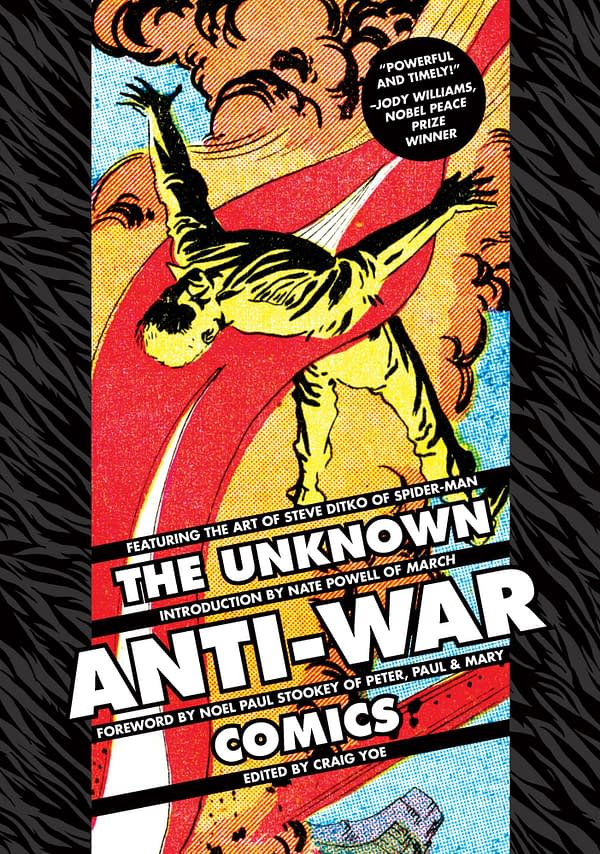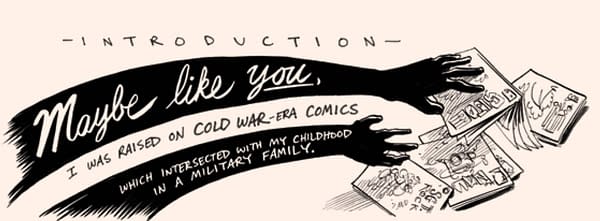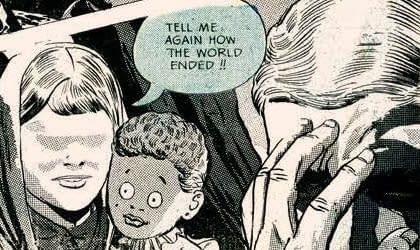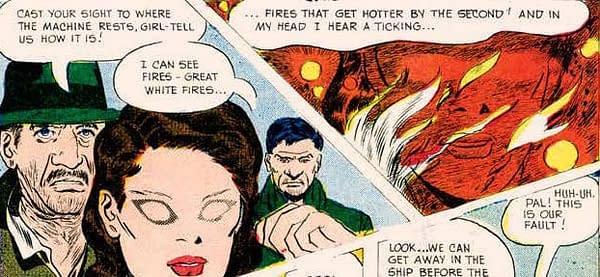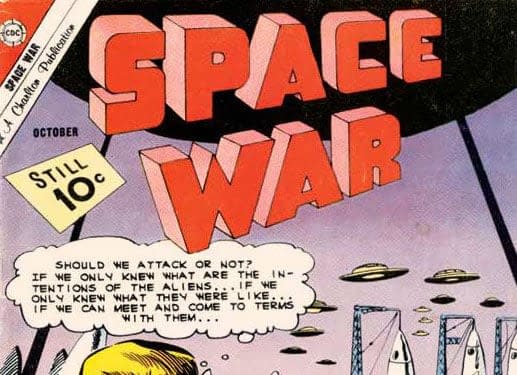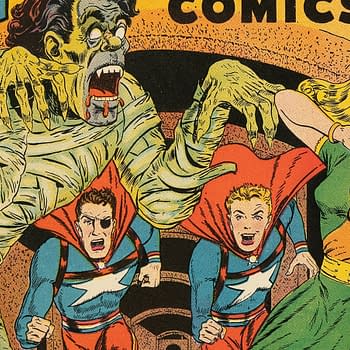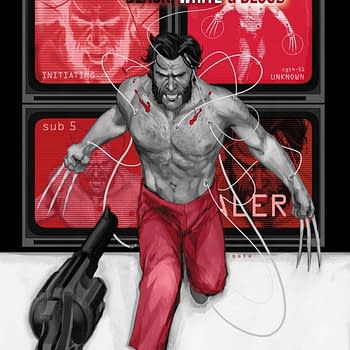Posted in: Comics, Comics History, Comics Publishers, IDW, Recent Updates | Tagged: Alan Moore, Craig Yoe, steve ditko
Watchmen's Historical Precursors Brought to Light in Craig Yoe's 'The Unknown Anti-War Comics'
Reading through Craig Yoe's excellent and surprising The Unknown Anti-War Comics is a sharp reminder of the shifting political realities of that era of history. If you love comics history or the wider scope of American history, examining the material of this book will surprise you. And whether you did or didn't live through that era of history, you might find that these comics are nothing like what you thought they were.
There's an implied notion of undisciplined counter-culture embedded in the time and place these comics come from, and in the very term "anti-war". One can almost imagine Timothy Leary's "tune in, turn on, drop out" refrain as being completed with "…and read some comics" when one thinks of anti-war culture at that moment in time.
But a close reading of The Unknown Anti-War Comics puts me in a state of mind that feels incompatible with 1960s counterculture. What we think of as pop art pulpy college hippy kid entertainment feels more like cold war calculation when read with the benefit of 50 years of distance. The comics of the prior World War II era were meant for a world at war on the ground, at sea, and in the air. These anti-war comics were intended for a world engaged in a battle that was ideological — a culture war. Yoe's choice of stories here makes this volume an excellent hook into understanding a dimension of comics and pop culture history that deserves much more scrutiny than it has received so far.
Before we get to that, though, I want to start with a confession: I'm usually that guy who skips introductions and jumps straight into the stories of collected volumes like this, but Yoe typically does a great job in selecting contributors that make for must-read material to preface his books. Gene Simmon's claim that it was Steve Ditko's Doctor Strange who inspired him to start throwing up devil horns at concerts in the intro for Super Weird Heroes Volume 2 is one highly entertaining example of this.
And indeed, artist Nate Powell's comic-format intro to The Unknown Anti-War Comics has me at hello. Panel one, caption one explains that Powell's father's comic book of choice was Blackhawk growing up, while Powell read the likes of G.I. Joe and The 'Nam himself. This shared experience gave father and son a springboard for discussing the complexities of war in the context of Powell's father's military service.
I can't help but note that in the second introduction to this volume, Noel Paul Stookey — who is the Paul in Peter, Paul and Mary — also singles out Blackhawk as among his favorites growing up, and asserts that in contrast to the World War II era, the anti-war movement of the subsequent era was met with suspicion, and the anti-war comics as typified in this volume "found little or no resonance with readers."
But I think the sentiment Stookey suggests here as someone who was central to the culture of that moment is surprisingly revelatory, and perhaps unintentionally so. I think it's possible that just as Blackhawk found the audience it was intended to influence in men like Nate Powell's father, so did these anti-war comics find the audience they were intended for in people like Peter, Paul and Mary, whose music became part of the soundtrack of the socially conscious anti-war activism of the era.
Because Blackhawk was almost certainly a direct example of purposeful wartime propaganda, designed to promote American know-how and confidence. The Blackhawk's plane was modelled after a real-life aircraft called the Grumman XF5F Skyrocket. The Grumman Skyrocket was part of a massive media blitz in newspapers and magazines across the country from 1940 to 1942, which generally touted the aircraft as the fastest and most deadly war machine to ever take flight. The XF5F never made it past the testing stage, but when a successor model was later put into production, it again received a renewed media blitz which included model kits and cereal boxes. It might also be noted that in recent years, the Skyrocket's manufacturer has collaborated with a major comics publisher on a comic that included a version of its best-known aircraft, which has assumed the mantle of most deadly war machine to ever take flight.
Another aviation comic book title, Airboy, can even be thought of as sort of the Cold War opposite of Nate Powell's collaboration on the graphic novel series March with civil rights leader and U.S. Congressman John Lewis. Whereas March is a chronicle of Lewis's civil rights efforts, Airboy might be considered something very different indeed. Unknown to the public, a member of Congress had some involvement with the publication of Airboy as well. Senator Styles Bridges was a board member of Hillman Periodicals, and as a member of the Senate Armed Services Committee, held considerable sway over the entire American aviation industry at the time.
As for why I'd disagree with Noel Paul Stookey's conclusion that the anti-war comics of the subsequent era didn't find their audience, Yoe's own written introduction to this volume provides the bridge we need to reach that conclusion — and in fact he drops a tidbit here which serves to perfectly illustrate why I find this volume so valuable. I had the below thumbnail version of the origins of CIA propaganda efforts laid out as I was drafting this article, and was debating whether it was all that relevant to my take on this book or if I was just indulging my nerdy interest in obscure pop culture-adjacent history. Then the importance of one of the elements of Yoe's introduction dawned on me.
Yoe notes that Alan Moore has cited a story that appears in this volume of The Unknown Anti-War Comics, the 1967 Charlton Premiere story Children of Doom by Denny O'Neil and Pat Boyette, as among the Charlton comics that stand out to him from this period. And… that might just provide a glimpse of insight into Watchmen, and how that legendary work fits together with another Moore graphic novel which was published while Watchmen was in progress. Brought to Light is a collaboration with Bill Sienkiewicz that explores the machinations of the CIA during just the period we're talking about here.
If one were to think of the Cold War era as an historic equivalent of a fictional universe, the foundational documents of that universe, or its origin story perhaps, might start something like this:
In 1947, with the Soviet Union attempting to spread communism around the world with the launch of an international network designed to spread disinformation and propaganda called COMINFORM (Communist Information Bureau, which itself was a reaction to Truman Doctrine and the Marshall Plan), the CIA was created in response to those efforts and others, a move towards formalizing and perfecting the country's psychological warfare and propaganda apparatus. As world events escalated — 1949 would see the Soviet Union conducting its first atomic bomb test, and Mao establishing Communist rule of China — CIA Deputy Director Frank Wisner emerged as the head of the Agency's propaganda efforts, which included domestic propaganda.
Wisner's exploits in the area of domestic propaganda led to FBI Director J. Edgar Hoover calling him and the operations he ran "Wisner's gang of weirdos". One of those weirdos, William Colby, likened the outfit Wisner created to "an order of Knights Templars, to save Western freedom from Communist darkness." When professionally humorless men in black like the notorious Hoover and Colby — a future Director of the CIA himself — are tagging someone with that sort of language, you know there's something historically bizarre going on. Wisner himself did nothing to dispel that notion with frequent boasts of what he glibly called his "Mighty Wurlitzer", likening the daunting misinformation infrastructure he had assembled to a magically powerful instrument of propaganda that he created and played. The implied boast being that people danced to his tune. Even whole countries of people, as if he was some super-powered pied piper.
Or… perhaps more like an infamous character from recent comic book history.
Long story short, the blueprint (pdf) that America's national security braintrust created and handed to Wisner to work into a script of sorts to move the entire country in the correct direction went something like this: he and his 'gang of weirdos' endeavored to drive home the necessity of a rapid expansion of America's military capability to keep the Soviets in check, emphasize the devastating consequences for the world if the Soviets or any other nuclear power were to use those weapons, and offering the path forward to happily-ever-after via UN efforts at promoting economic, agricultural, health and ideological stability, and unity. Giving peace a chance.
There's even a concrete example of this kind activity which is directly on point in the time and context that this volume of The Unknown Anti-War Comics covers. We've somehow forgotten that time when one of the burglars in the Watergate break-in turned out to be a CIA agent who was involved in domestic propaganda for Wisner — and also happened to have written a number of books published by the paperback divisions of comic book publishers like Fawcett and Dell among others. As the NY Times put it in the day, they are examples of "covertly political novels; propaganda… designed to influence feelings about real events by evoking the unpurged portions of the unconscious." The 1973 piece goes on to sketch out some rough outlines of this culture war:
Obviously a vast domestic and inter national cultural struggle went on, both overtly and secretly; novel against novel, comic strip against comic strip, television play against….
Among other things, Moore covers a few of the overall points above in Brought to Light, and even mentions that particular Watergate burglar noted above… yet doesn't go too deep into the details of the propaganda aspects, and doesn't mention Wisner. But perhaps that makes Watchmen the other side of the coin — Watchmen machiavellian antagonist Adrien Viedt's plan does sound an awful lot like Wisner's: create an escalating narrative of fear to get people focused in a certain direction, and just when it seems there might be no turning back, introduce a scientific terror beyond mortal reckoning, that… maybe… leads to an engineered state of peace.
In this context, Brought to Light and Watchmen can be looked at as companion works which were developed around the same time. Besides the titles whose characters ended up as inspiration for Watchmen, the other Charlton comics that Moore was familiar with — Children of Doom and others, the likes of which are represented this volume — serve as a sort of connective tissue between the two. Or perhaps background radiation.
At the very least, it's a pretty tall stack of coincidences, and we can add one more to the pile: Yoe notes at the end of his introduction that in high school in 1969, he worked on a high school underground newspaper called The Crocus, drawing anti-war cartoons alongside artist Paul Mavrides — who happens to have contributed to Brought to Light nearly 20 years later. More a resonating wave than just a chain of coincidences, I think. Ideological background radiation with a half-life that can be generations long.
Like Noel Paul Stookey, Yoe lived through and actively participated in the politics embodied in the anti-war comics in this volume. He was organizing student protests at the University of Akron just as tragic events at Kent State University a few miles away were shifting the course of US history. That makes his story choices here particularly interesting as historical documentation of this era of pop culture, and yet… as I did with Stookey, I find myself partially disagreeing with one of the notions he expresses about the era in his introduction. While that era is obviously the very definition of a "you had to be there to understand it" moment, I think there might be more to it than that.
Yoe quotes from President Dwight Eisenhower's 1958 "Space for Peace" proposal to Soviet Premier Nikolai A. Bulganin and notes it as a sharp contrast to current administration notions of militarized space. But history tells us that Eisenhower was likely off-script here. The Air Force and RAND resisted Eisnerhower's proposals with some tenacity, and so it seems did Wisner and his Mighty Wurlitzer.
One can interpret Eisenhower's infamous 1961 warning against the influence of the military-industrial complex as being directly on point here. There's a detectible uptick in media that was explicitly counter to his intentions in the time frame that begins with his 1958 proposal. To name one obvious example in comics, speaking of Charlton as we are so often here, one can't help but note that the publisher launched the title Space War shortly after that "Space for Peace" moment.
And speaking of Space Force, as Yoe did by way of contrast to Eisenhower's 1958 proposal in his introduction, it's likely no coincidence that year also saw the debut of the Jack Kirby and Dave Wood's newspaper comic strip Sky Masters of the Space Force. Yoe's reference was to the agency recently proposed by President Donald Trump. But just as the 1958 comic strip subtly implies a political path that diverged from Eisenhower's intent by maintaining military control of space — which in turn suggests one or two international treaties that wouldn't have happened — Trump's Space Force also likely implies eventual withdrawal from at least one of those same treaties: The October 1967 UN Treaty on principles governing the activities of States in the exploration and use of outer space.
Here again we observe the resonating wave of history in action: the President's suggestion was considered so randomly silly that it slipped right past the defenses of many who might otherwise have opposed the notion of further withdrawals from international agreements. Placed in the context of this history, it's a rather deftly executed bit of political propaganda which is a mirror of sorts to that sequence of events that began in 1958.
The era directly following the initial "Space for Peace" proposal would see quite a lot of space comics that weren't particularly anti-war at all. In addition to the seemingly clear intent of most of the content of Space War, Charlton titles such as Out of this World, Outer Space, Mysteries of Unexplored Worlds, and others contain a steady stream of comics stories that appear to be supportive of space militarization themes.
One particular pro-militarization story from this period is worth singling out for its stark contrast to the stories contained in this volume of The Unknown Anti-War Comics. Space Adventures #33 from 1960 contains a Steve Ditko story about an Air Force Captain who pilots a rocket containing a powerful atomic warhead into space. Its premise is in direct opposition to Eisenhower's "Space for Peace" proposal of two years prior. A terrible tragedy occurs in space, the warhead explodes, and the Air Force Captain is transformed into someone whose control over atoms gives him nearly inconceivable power: Captain Atom.
Of course, this is the inspiration for Watchmen's Dr Manhattan.
But as the 1960s dawned, the temporary technological and propaganda advantage that the success of the Sputnik and Vostok programs gave the Soviet Union, along with the increasing inevitability of the Limited Nuclear Test Ban Treaty (which among other things, prohibited the testing of nuclear weapons in space) forced the Mighty Wurlitzer to change its tune.
Menace from Beyond from Unusual Tales #23, August 1960 is a concise example of a type of story that would increasingly appear. Jumping to the spoiler at the end, one of the masterminds of this tale exclaims: "Gentlemen, it has worked! For generations mankind will band together to fight what they think will be invasion from outer space!" They'd faked invasion by an overwhelming alien power in order to unite Earth in peace.
The Charlton story that stood out to Moore, Children of Doom, seems to provide the alternative path that continues from Watchmen's climax. The UN's peacekeeping mission is noted here, but now the implication is that the Cold War arms build-up is destined to fail. An analog to Watchmen's Doomsday clock — an actual Doomsday Machine — is introduced. Then it all starts to go horribly wrong.
And finally, The Land of Peace from Unusual Tales #42, November 1963, is noteworthy for taking a slightly different approach, and showing us the happy ending that Watchmen left as an open question. The unimaginably advanced alien in this story shows key scientists from the U.S., Russia, and China two alternative versions of the future. In one version, nuclear war ultimately destroys the planet. In the other, the planet as a whole becomes prosperous, people have economic security and no one goes hungry. The sequence ends with a note that this is a peace "in which all men of all backgrounds can live together without fear", while the panel itself depicts the central chamber of the UN. The narrative here reads like it could have come directly from early 1950s State Department directives outlining the goals of that global organization.
The Unknown Anti-War Comics contains many entertaining variants on the theme of unimaginable alien forces causing mankind to unite, but these seem to be directly on point. They seem to be precursors to Watchmen's climactic moment. The propaganda apparatus that Wisner conceived has sometimes been been referred to as the Manhattan Project of the mind, and that too seems to have an uncannily accurate echo in Moore's work. Veidt's scenario also involved a massive burst of psychic energy, rather than atomic energy.
The world was mentally traumatized into taking steps towards uniting.
All of this is not to say that the comics industry was full of CIA agents like E. Howard Hunt, busily scripting their way towards a happy ending for America from month to month. Nor is it to imply that for all of Frank Wisner's boasting, the likes of Peter Paul and Mary were playing blithely along to the tune that his "gang of weirdos" had written.
But I do think that the stories these comic book pages contain are the end result of quite a bit more calculated intent than we generally think about. Cultural influencers from Ernest Hemingway to William F. Buckley to Gloria Steinem worked with the CIA. Add in hundreds of other writers of fiction, journalists, and filmmakers; not to mention the fact that media magnate Henry Luce, the publisher of Time, Life, Fortune, and Sports Illustrated, is known to have had a close relationship with the Agency during the course of his career, and it's not too hard to imagine how this worked.
The Wurlitzer played tunes, people who liked what they heard hummed along from time to time. Perhaps people like Nate Powell's father took a tiny bit of inspiration from Blackhawk to stand up for his country, and perhaps Peter, Paul and Mary took a little inspiration from material like some of the comics in this volume to stand up for their country also. And if you don't think a government would want to inspire activism to cause a particular outcome, I'd gently suggest that you haven't been keeping up with the news lately.
I get the impression from reading Craig Yoe's and Noel Paul Stookey's introductions to this volume of The Unknown Anti-War Comics that they — as part of the generation who actively participated in this moment of history — haven't considered that this might be possible. But of course, what the hell do I know, anyway — just by studying the metadata that enabled these comics to be transmitted to the masses, from a distance of 50 years?
Only this: I told Craig while I was writing this piece up that I'd concluded that The Unknown Anti-War Comics was his most important collection of comics history to date, and that is exactly why. It's not the "doomed to repeat it" cliche, because that's a foregone conclusion. It's not even that history can be used as a weapon, because that's inevitable too. It's simply that when you get hit by a resonating wave — a cultural force that is not like background radio static, but moves you because it has shape, structure, and distinct and repeating beats — it's worth examining whether you've been humming along to somebody else's tune.
Craig Yoe's The Unknown Anti-War Comics is available to purchase online now, and you can also in comic shops and bookstores everywhere.


